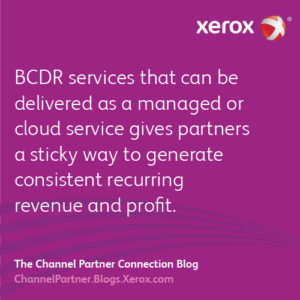
What is BCDR?
Though it rarely ranks high on surveys of a majority of solution providers’ marquee offerings, BCDR is, in reality, an important core service that’s a must-have on the bill of fare of any partner who professes to offer a complete IT service.
The concept of BCDR goes beyond merely backing up data files; a robust BCDR service needs to consider all of the IT systems that must be protected and made available during a significant downtime event. For managed services partners with ancillary print practices, that means strong consideration of how to safeguard print configuration and how all critical imaging and document management functions will be handled when disaster strikes. And disaster will strike.
So many hard drives, so little planning
Consider these sobering statistics: Of the roughly 650 million hard disk drives we put into service every year in desktops, laptops, servers, storage arrays and multi-function printers, up to a quarter of them can be expected to fail annually, according to research by cloud storage provider Backblaze.
Worse, 96 percent of business workstations are not being backed up, according to a study by Contingency Planning and Strategic Research Corp. And if you think you and your customers are safe with dated or cobbled-together backup systems, think again. The Boston Computing Network found 77 percent of businesses with tape backup have flaws that could impede recovery and half of them have been provably shown to fail in restoration attempts. Exactly half of tape backup flat out fail to restore, according to Gartner.
So how perilous is this shortcoming? Quite, as it turns out. A study by the University of Texas found that 94 percent of companies that suffer a catastrophic data loss and haven’t backed up do not survive — 43 percent simply never reopen and 51 percent go out of business within two years.
Every cloud has a silver lining
So there’s the bad news. The good news is that channel partners have many options, from multi-location on-premises BCDR systems to cloud backup and recovery services along with many hybrid option in between. And these aren’t just good for the customer’s business; they benefit the solution provider as well.
In our most recent research on the channel BCDR market, The 2112 Group found that 36 percent of solution providers listing BCDR as a top seller also predicted their revenue growth this year would top 21 percent. About one-quarter of the of the BCDR champions pegged their growth at 31 percent or higher as compared to the channel’s average overall growth of around 17 percent
That optimism is beginning to warm up what had traditionally been a sluggish channel market for backup and recovery services. The BCDR market is now expected to top $40 billion by next year, according to Allied Business Intelligence Inc.
So the benefits of prudent and responsible backup services are obvious, but how does a partner develop a BCDR practice that truly safeguards everything from mainframes to multi-function printers?
Six steps for developing BCDR offerings
We suggest service providers follow a simple, six-step process to develop effective and right-sized BCDR offerings that maximize partner profit potential while delivering superior customer service.
Start with assessment
BCDR sales require thorough knowledge of all of a client’s systems along with a deep understanding to their needs. Here you’ll determine what IT components are critical to the business and what kinds of continuity or recovery mechanisms may already be in place.The assessment phase begins by cataloging the customer’s policies and standards with an eye toward understanding the operational requirements and environment. These should be mapped to the customer’s revenue-producing systems and regulatory requirements.
Part of the assessment phase involves scrutinizing existing systems. Outdated or sub-standard hardware, networking, storage, security, applications and bandwidth may not be able to support modern backup and recovery regimens. This is a good opportunity to suggest upgrades and replacements.
Build a business impact assessment
The initial assessment results in a Business Impact Statement, or BIA, which details responsibilities and protocols, and lists the order in which systems will be restored. The BIA should cover elements of the disaster recovery plan beyond just the basic IT concerns. Where and how will workers print, for example? What if the phones are not working? Where will they meet and work if the main site is inaccessible? Can they work there? Who makes the call that sets the recovery plan into action? Who signals the all-clear?
Craft a comprehensive plan
The ultimate product of this in-depth organizational analysis is a comprehensive BCDR plan that includes all facets of the BIA along with more technical specifications such as data recovery stratification mapping, testing schedules and contact trees.
State the value
With the comprehensive BCDR plan in place, it’s time to aggressively make your case for the BCDR sale, a process that starts with honing your service’s value proposition. Remember, the value your backup and recovery practice brings is defined not by the technology tools, but rather by the inherent value in the plans, policies, processes and professional support being delivered in the engagement.
Brand BCDR boldly
With the value proposition in hand, it’s time to package the solution under your own brand. The most successful partner backup practices always lead with their name, not the name of the vendors upon which the solution is built. Remember, it’s your value proposition they are buying, make sure the solution brand fulfills that promise.
Remember the fine print
The final step in crafting a well-conceived and boldly-branded BCDR offering is developing supporting materials such as contracts and SLAs. Unlike many other IT services, a BCDR engagement is selling performance by contract. The real value lies within contractually expressed functions like recovery time objectives (RTOs), recovery point objectives (RPOs) and recovery granularity objectives (RGOs).
The addition of BCDR services that can be delivered as a managed or cloud service gives partners a sticky way to generate consistent recurring revenue and profit, as subscribing customers tend to avoid dropping such services or switching providers.
The opportunity for channel partners
Cloud-based and hybrid backup services can offer solution providers an entry point into a potentially lucrative market segment on their own, or they can be used to augment existing services with relatively low risk. To capture this opportunity, however, channel partners must focus on sales and customer engagements, continually build their customer base and upsell existing accounts. Those that can find this focus – and the right blend of BCDR services for their clients – will be rewarded.
So give BCDR some respect. You’ll be doing the right thing to protect your clients and you’ll be growing your services practice with an offering that will continue to pay off for the long haul.
Subscribe to the Channel Partner Connection and receive email updates when we publish a new article.
(This article was first published on IT:Connect & Expand, a 2112 Strategy Group blog presented by Xerox for managed service providers.)



